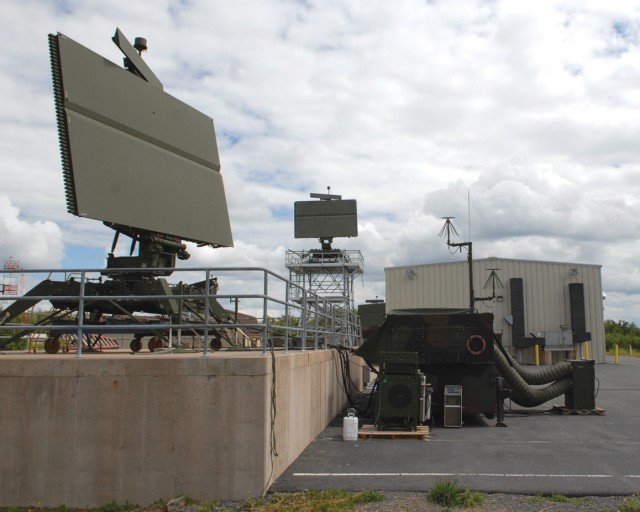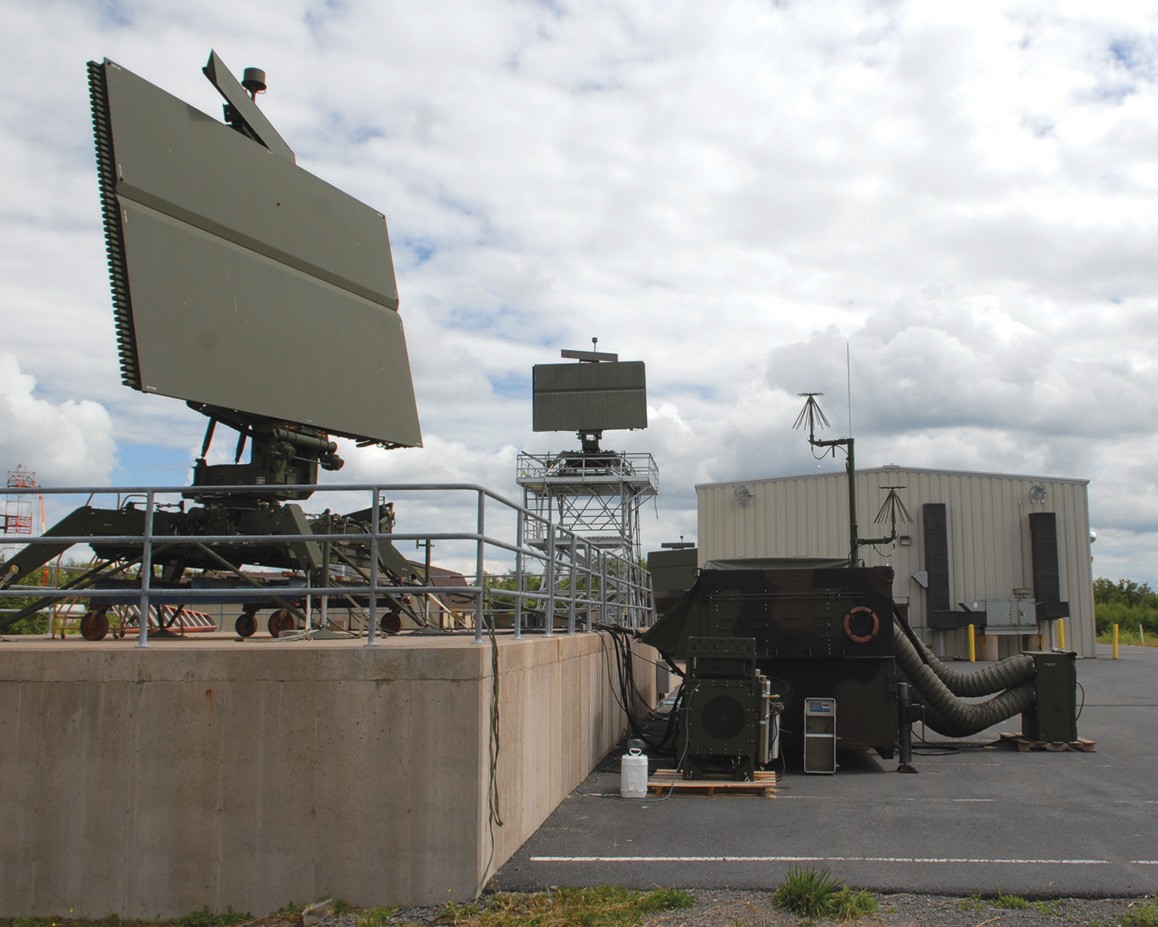TOBYHANNA ARMY DEPOT, Pa. - Editor's Note: This is the first of three articles highlighting Tobyhanna Army Depot's support of U.S. Air Force systems. This article focuses on systems managed by the Ogden Air Logistics Center, Utah.
The U.S. Air Force Depot Maintenance mission is a function of the U.S. Air Force Materiel Command with depot maintenance being managed by three Air Logistics Centers. Ogden Air Logistics Center, located at Hill Air Force Base, Utah, is responsible for Range Threat Systems, Air Defense Radars, Ground Theater Air Control Systems, Maverick Missile Guidance Systems and Communications Systems.
Tobyhanna is the source of repair for these critical systems that are a significant part of its workload.
"Our support to the Air Force is another venue for Tobyhanna to provide excellent support to the warfighter," said Patrick Esposito, director of the depot's Production Management Directorate. "While Tobyhanna is a subordinate organization within the United States Army, we truly provide joint support to all of the services. The Air Force is a large portion of that support, and it is a portion that we are proud of."
The depot's support of key Air Force systems has earned awards as well as praise from Air Force officials.
Two of those systems, the AN/TPS-75 Air Defense Radar System and the AN/TYQ-23 Tactical Air Operations Module, are included in Tobyhanna's list of national-level awards for quality.
Technicians have repaired and tested the AN/TYQ-23 since 1998. The primary depot shop for the mission is the Command and Control Branch. The branch is part of the Command, Control and Computer/Avionics Systems Directorate's Command, Control and Computer Systems Division. Another organization involved is the Refinishing Services Division, Systems Integration and Support Directorate.
Technicians repair and test power supplies and other individual AN/TYQ-23 components sent from the field, not just entire systems.
The AN/TYQ-23 is a mobile command, control and communications facility that provides the ability to plan, direct and execute airspace management activities. An AN/TYQ-23 can interface with up to four AN/TPS-75 Air Defense Radar Systems and is also used by the Army and Navy for voice and data communications.
George Bellas, director of the Command, Control and Computer/Avionics Systems Directorate, said the system is the keystone of all communications systems used in the tactical theater. The AN/TYQ-23 processes data from the AN/TPS-75 and sends it to other communications systems.
Experience integrating Lean techniques and working closely with the Air Force has allowed technicians to reduce the repair cycle time from 150 to 115 days for Air Force systems. Officials anticipate reducing this to 90 in the near future and reducing Marine Corps systems time from 90 to 60 days. This translates to about 11 systems per year, up from three per year.
"We have reduced the unit funded cost from $435,000 in 2006 to $406,000 in 2007," added Jerry Dougher, chief of the Command, Control and Computers Systems Division.
"Tobyhanna Army Depot and Ogden (Air Logistics Center, Utah) have been able to work together resulting in continuous improvements to processes, communication and quality," said Nate Wallwork, operations lead, Integrated Product Team, Hill Air Force Base, Utah. "Today's end product demonstrates the dedication and teamwork efforts that Tobyhanna Army Depot has developed, grown and implemented."
Wallwork noted that Tobyhanna maintains open and honest communications with Ogden ALC officials.
Tobyhanna technicians' improved support of the system earned a Shingo Bronze Medallion in 2008.
The Bronze Medallion is part of the Shingo Prize for Public Sector Excellence in Manufacturing category. The prize recognizes U.S. organizations that have demonstrated outstanding achievements in Lean manufacturing (including maintenance, repair and overhaul) and the supporting business processes leading to outstanding quality, cost, delivery, and business and financial results.
But the AN/TYQ-23 is not the only Air Force system for which the depot has earned a Shingo award. Lean and other improvements to the AN/TPS-75 mission netted the depot's first Shingo award in 2006, a Bronze Prize for Public Sector Excellence in Manufacturing.
The TPS-75 is a mobile, tactical radar system capable of providing long-range radar azimuth, range and height information, along with identification friend or foe capability for operations and control of tactical aircraft. The radar is the U.S. Air Force's primary Surveillance Radar System and is deployed worldwide.
Part of the Ground Theater Air Control System, it provides "real time" radar airspace pictures and data in support of the battle commander.
Tobyhanna technicians achieved a 31 percent reduction in its RCT and a 25 percent reduction in overhaul repair costs for the AN/TPS-75.
Recently, a third test pad was installed to reduce the repair cycle time further. Now technicians can test three complete systems and a stand-alone antenna concurrently at the depot's Powder Smoke Ridge Test Facility.
Franklin Frey, chief of the Surveillance Systems Division, which is part of the depot's Intelligence, Surveillance and Reconnaissance Directorate, said they can test four systems simultaneously if necessary.
The continuous effort to reduce repair cycle time has led Michael Corley, an AN/TPS-75 program manager, to characterize Tobyhanna's support as 'extremely satisfactory.' He said that Tobyhanna's strength is that leadership understands and communicates to their team that the mission of the AN/TPS-75 is to provide a detailed air picture over specific and carefully selected areas of operation, to provide real-time surveillance of airspace in support of high value ground assets, and to ensure flight safety of U.S. and Coalition aircraft flying in the theater of operations.
"They understand that mission crews from the Control and Reporting Center rely on this radar picture in order to conduct specific mission tasking from the Joint Forces Air Component Commander," he continued. "Because of their thorough understanding of the mission, they realize that the loss of even one of these radars constitutes a critical mission failure and has a direct impact on both flight safety and protecting ground forces in direct contact with the enemy.
"The knowledge of this critical mission is the impetus behind the continued sense of urgency displayed by the entire team whenever a unit needs parts or technical assistance."
"Our relationship has certainly evolved over the years," Esposito said. "We have experienced a tremendous improvement in our communications with our Air Force Customers which, as simple as it sounds, has provided us with faster, more accurate sharing of information resulting in a much better understanding of each other's business processes. This understanding has helped us improve our overall support to the end-user."
Esposito said that through the quarterly Program Management Reviews. Tobyhanna has been able to develop a closer relationship which has enabled the depot to plan and execute Air Force requirements to the highest standard.
Corley added that the Tobyhanna team can be counted on to continually provide expeditious support whenever it is required, describing an incident in which an antenna could not be folded. Tobyhanna and Ogden personnel worked together to create an in-field fix action to remove and replace the antenna gearbox and jackscrew assemblies.
"There were no written Technical Order instructions to accomplish this and it was never performed in the field by military personnel," Corley said. "In addition, it was not normally accomplished by Tobyhanna personnel in the configuration the antenna was in at the time."
To resolve this issue, Tobyhanna personnel created step-by step procedures, including pictures to identify parts and text information, to walk the Air Force radar technician through the removal and replacement process.
"Maintenance personnel received these instructions and performed the maintenance action flawlessly," Corley said. "From start to finish, the process taken by Tobyhanna Army Depot and the ALC allowed for an effective and efficient maintenance action to be performed without having to send Tobyhanna personnel to the [field]."
Corley added that Tobyhanna has developed methodologies for responding rapidly to the warfighter needs. For example, when systems supporting the area of responsibility and Operation Noble Eagle missions required parts that have long lead times to acquire, Tobyhanna assists by sending parts that are earmarked for a Programmed Depot Maintenance system to the units, usually within 24 hours.
"Continuous improvement is what this business is all about, and it is no different with our support to Air Force customers," Esposito said. "Improvements to processes lead to lower repair cycle times and lower repair costs. If our quality levels remain high and our cost and turnaround times continue to improve the Air Force will continue to see us a valued service provider and will continue to seek us out as their logistics center of choice."
Esposito said the depot continues to work with Air Force Program Offices to establish new capabilities and bring in new workloads. The Air Force Range Threat Systems Program Office has recently approached Tobyhanna about developing additional capabilities for the Unmanned Threat Emitter System. The depot has also submitted a proposal for support of the Joint Threat Emitter.
Michael Barnes, the director of the 415th Supply Chain Management Squadron at Hill AFB, said that Tobyhanna has made continuous progress in improving support to the Air Force over the last five years.
"Today, I consider them one of the premier maintenance and repair organizations for support of Air Force items," he said. "Because we deal with over 165 different contractors and organic suppliers, being one of the best means a lot. If Tobyhanna keeps improving their ability to do a quality job at a fair price, with shorten repair times, we will make every effort to direct as much of our work to them as possible."
Tobyhanna also supports the following Air Force systems for Ogden ALC:
Aca,!AcAN-AGM-65 Maverick Missile guidance and control system
Aca,!AcShelter Corrosion Prevention and Mobile Depot Maintenance for Category 7 Ground Communication Equipment Shelters.
Aca,!AcAN/VPQ-1 Tactical Radar Threat Generator.
Aca,!AcAN/MSQ-T43 Modular Threat Emitter.
Aca,!AcAN/MST-T1A Multiple Threat Emitter System.
Aca,!AcAN/MST-T1V Mini-Multiple Threat Emitter System.
Aca,!AcAN/MPS-T1 Receiver/Transmitter and control van.
Aca,!AcAN/FRC-181 MILSTAR Command terminal.
Aca,!AcAN/FPS-117 Phased array antenna radar.
Aca,!AcAN/TRC-194 MILSTAR ground command post
Tobyhanna Army Depot is the Defense Department's largest center for the repair, overhaul and fabrication of a wide variety of electronics systems and components, from tactical field radios to the ground terminals for the defense satellite communications network. Tobyhanna's missions support all branches of the Armed Forces.
About 5,600 personnel are employed at Tobyhanna, which is located in the Pocono Mountains of northeastern Pennsylvania.
Tobyhanna Army Depot is part of the U.S. Army CECOM Life Cycle Management Command. Headquartered at Fort Monmouth, N.J., the command's mission is to research, develop, acquire, field and sustain communications, command, control computer, intelligence, electronic warfare and sensors capabilities for the Armed Forces.


Social Sharing